Navigation
This article applies to all 7.x versions of Citrix Provisioning, including 2411, 2402 LTSR, and 2203 LTSR.
- Change Log
- PXE Tester
- Convert to vDisk – Imaging Wizard Method
- Join Device to Domain
- Boot from vDisk
- Save Clean Image
- KMS
- Seal the vDisk
- Defrag the vDisk
- Standard Image Mode
- vDisk High Availability
- Create Cache Disk – vSphere
- Create Cache Disk – Hyper-V
- Verify Write Cache Location
💡 = Recently Updated
Change Log
- 2019 Jun 23 – KMS– new Accelerated Office Activation option in Provisioning 1906
- 2019 Jun 8 – vDisk HA – added link to Citrix Blog Post The vDisk Replicator Utility is finally finished!
- 2018 Sep 3 – renamed Provisioning Services to Citrix Provisioning
- 2018 June 9 – vDisk HA – added link to Citrix Blog Post vDisk Replicator Utility
- 2018 Jan 14 – in Defrag vDisk section, added note that ELM App Layering doesn’t need defrag. Source = Gunther Anderson at Performance considarations? at Citrix Discussions
- 2017 Dec 14 – in Imaging Wizard > Boot from PVS section, added P2PVS.exe
PXE Tester
If you will use PXE, download CTX217122 PXEChecker to the master machine.
The TFTP portion won’t work unless the client-side firewall is disabled.
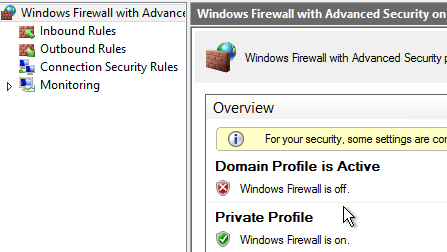
To verify functioning PXE, run PXEChecker, and Run Test in Legacy BIOS mode. Or you can do a BDM Test (see the article for details).
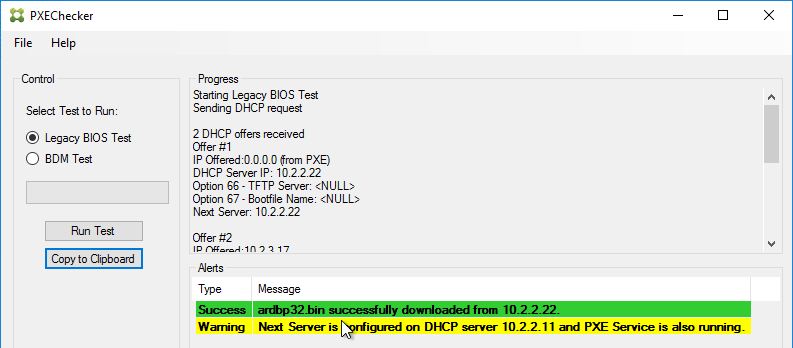
Convert to vDisk – Imaging Wizard Method
The Imaging Wizard connects to a Citrix Provisioning server to create a vDisk (.vhdx file) and a device (database entry with device’s MAC address). Once that’s done, the machine reboots and the conversion process begins. You can also do all of these steps manually.
- In the Citrix Provisioning Console, create a Store to hold the new vDisk.
- In the Citrix Provisioning Console, create a Device Collection to hold the new Target Device. This could be a Device Collection for Updater machines.
- The Imaging Wizard will ask you to enter a new machine name. You can’t use the existing machine name because Citrix Provisioning needs to create a new Active Directory account so Citrix Provisioning will know the new machine’s computer password.
- If the Imaging Wizard is not already running, launch it from the Start Menu.
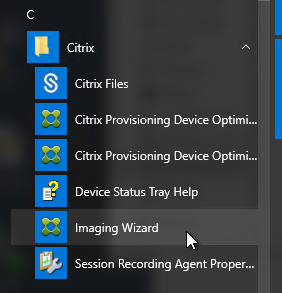
- In the Welcome to the Imaging Wizard page, click Next.
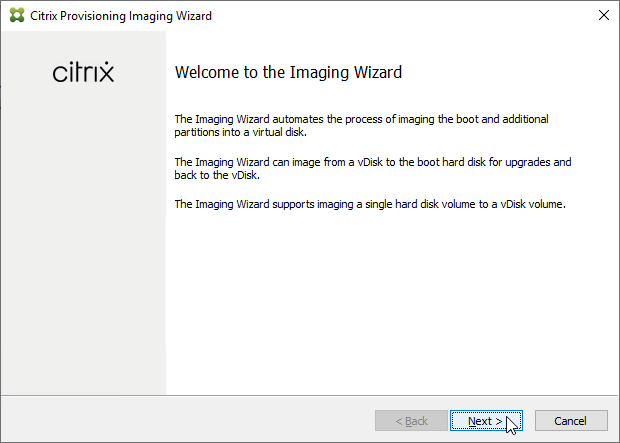
- In the Connect to Citrix Provisioning Site page, enter the name of a Citrix Provisioning server, and click Next.
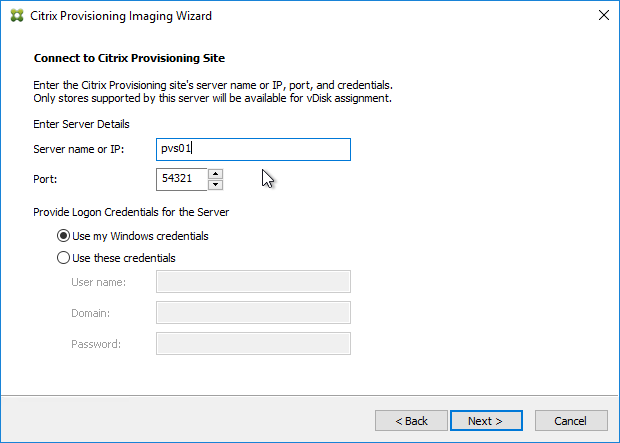
- In the Imaging Options page, click Next to create a new vDisk. Alternatively, you can select Create an image file.
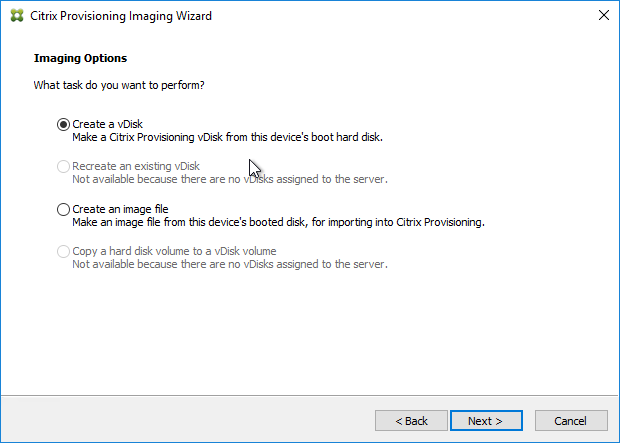
- In the Add Target Device page, enter a new unique name for the new Target Device.
- Select a Collection name and click Next.
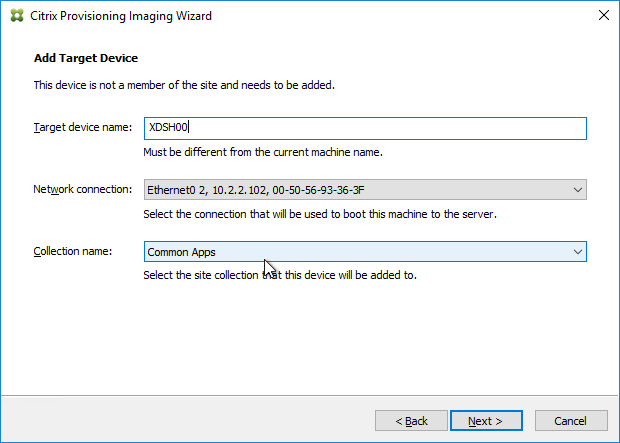
- In the New vDisk page:
- Enter a name for the vDisk.
- Select an existing Store name.
- Leave vDisk type set to Dynamic and VHDX.
- Click Next
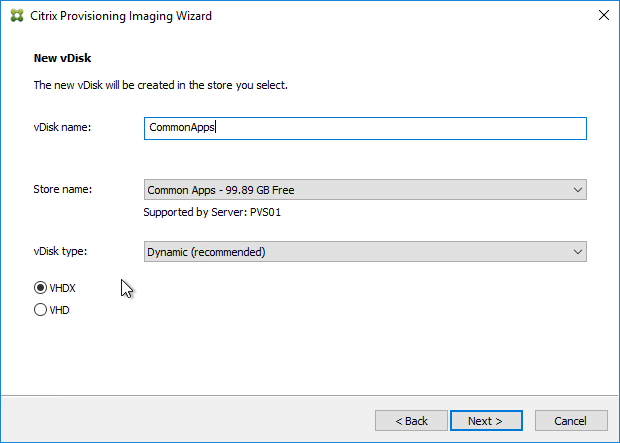
- In the Microsoft Volume Licensing page, select None, and click Next. We’ll configure this later when switching to Standard Image mode.
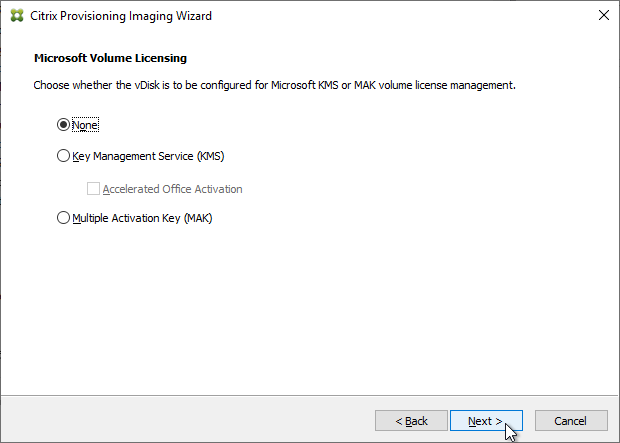
- In the What to Image page, leave it set to Image entire boot disk, and click Next.
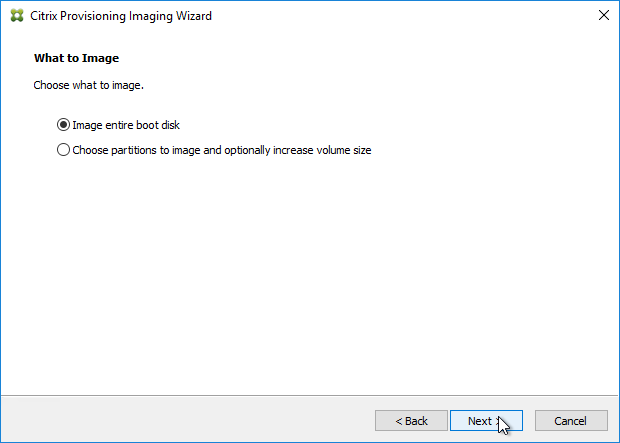
- In the Optimize Hard Disk for Citrix Provisioning page, click Next.
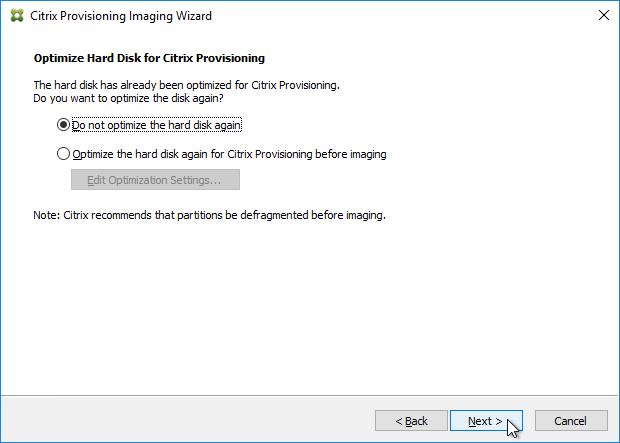
- Shown below are the optimizations it performs.
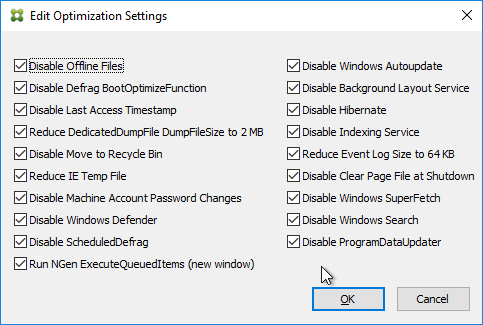
- Shown below are the optimizations it performs.
- In the Summary page, click Create.
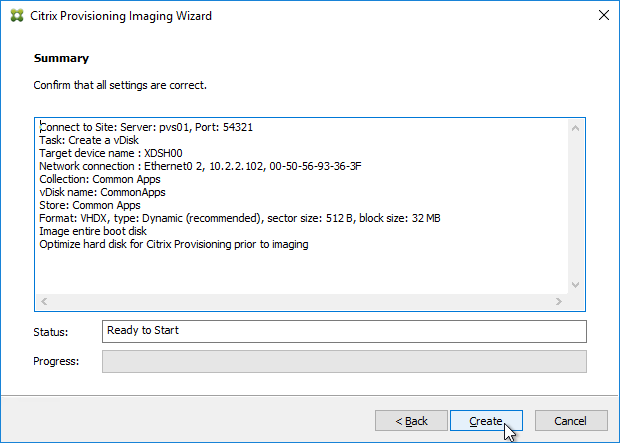
- In the Restart Needed page, click Continue.
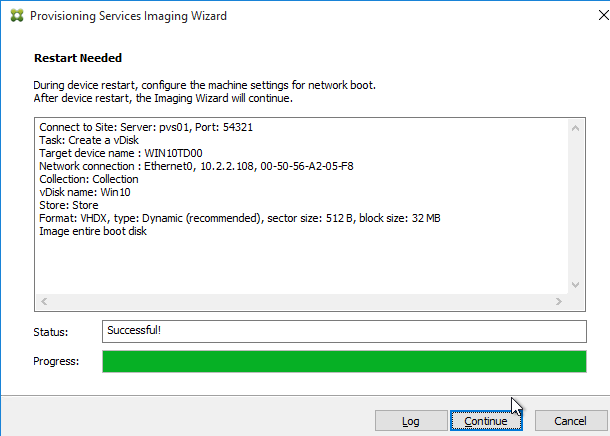
- When asked to reboot, click No.
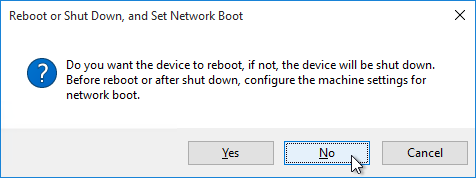
- Then click Yes to shut down the machine. This gives you time to reconfigure the machine to boot from the network or ISO. The vDisk conversion process cannot continue until you are booted from Citrix Provisioning.
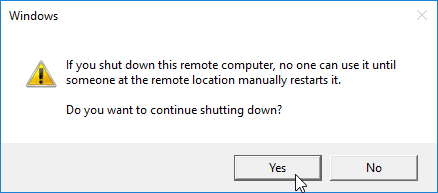
- If you look in the Citrix Provisioning console, in the Store, you will see a new vDisk in Private Image mode. Currently there is nothing in this vDisk. The new vDisk is sized the same as the machine you ran Imaging Wizard from. You might have to Refresh the display to see the new vDisk.
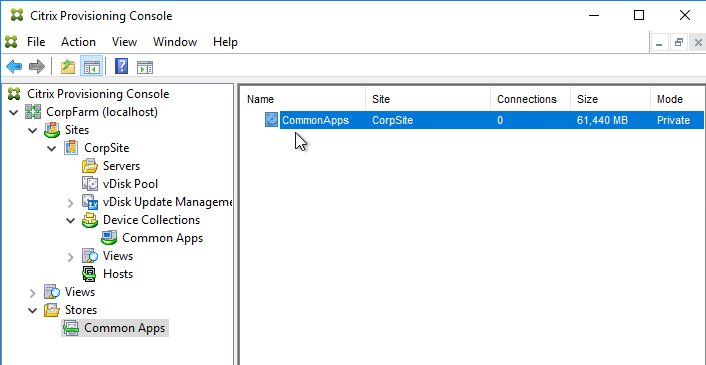
- In the chosen Device Collection, you will see a new Target Device record that is configured to boot from Hard Disk, and is assigned to the new vDisk. You might have to Refresh the display to see the new Device.
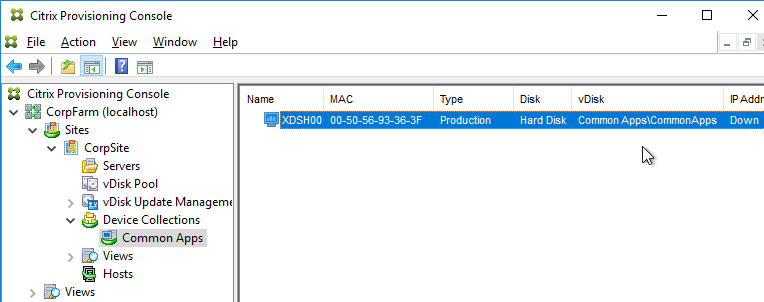
Boot from Network or ISO
- Power off the Target Device.
- If the Target Devices are on the same subnet as the Provisioning Servers, then you don’t need to configure DHCP Scope Options 66 or 67.
- EFI/UEFI devices require DHCP Scope Option 11 as described at CTX208519 Configuring PVS for High Availability with UEFI Booting and PXE service. DHCP Scope option 11 can have multiple PVS Server addresses.
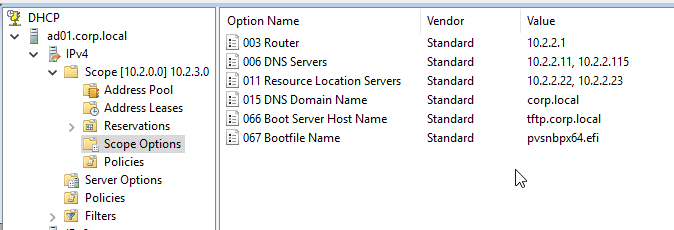
- EFI/UEFI devices require DHCP Scope Option 11 as described at CTX208519 Configuring PVS for High Availability with UEFI Booting and PXE service. DHCP Scope option 11 can have multiple PVS Server addresses.
- If the Target Devices are on a different subnet than the Provisioning Servers, then machines can use a Boot ISO that has UEFI enabled. Or configure DHCP Scope Options 66 and 67.
- For DHCP Scope option 66, you can only configure one TFTP Server address. For HA, you can enter a DNS name that does DNS round robin to multiple Citrix Provisioning servers. Or use Citrix ADC to load balance the TFTP service on the PVS servers.
- Configure DHCP scope option 67 with the correct file name. For the EFI file name. See Unified Extensible Firmware Interface (UEFI) pre-boot environments at Citrix Docs.
- For vSphere Client, edit the settings of the virtual machine.
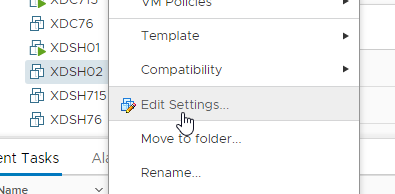
- Switch to the VM Options tab.

- In the Boot Options section, check the box to Force EFI Setup, or Force BIOS Setup.
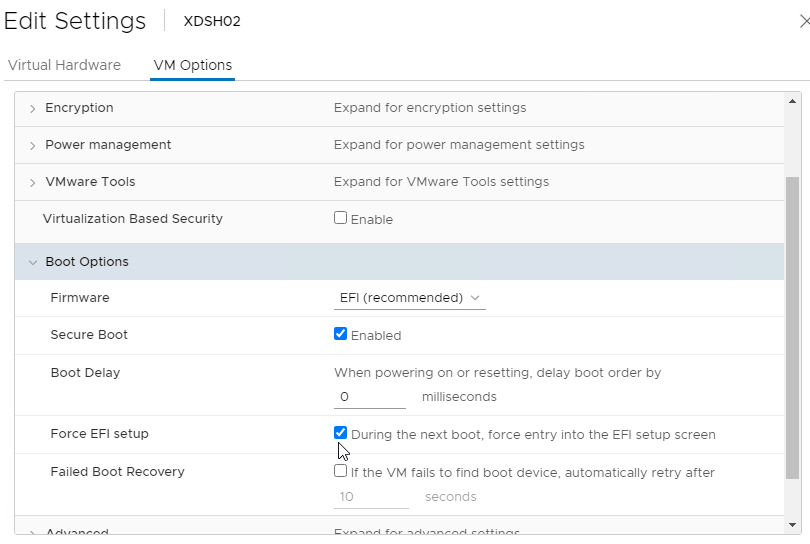
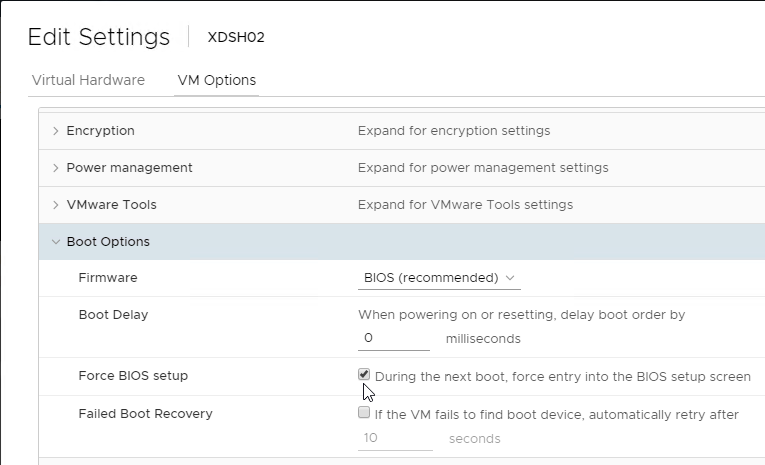
- If vSphere, and booting from an ISO:
- Switch to the Virtual Hardware tab.
- Expand CD/DVD drive 1 and connect the virtual machine’s CD to the Datastore ISO File named PvSBoot.iso.
- Make you check Connect At Power On.
- Make sure the CD-ROM is IDE, and not SATA.
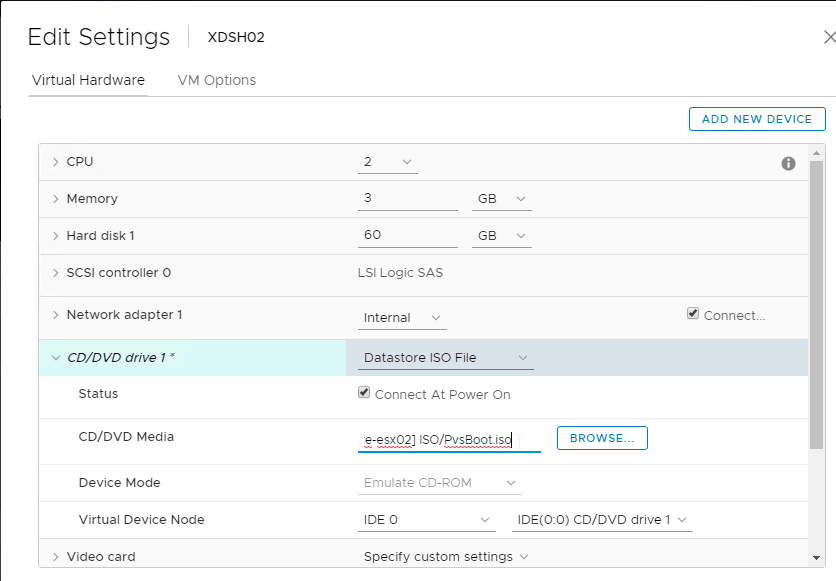
- Also, remove any SATA controller.

- Click OK to close the virtual machine settings.
- If Hyper-V:
- In VMM, edit the virtual machine properties
- Switch to the Hardware Configuration page.
- If booting from ISO, in the Virtual DVD drive page, assign the ISO from the library.
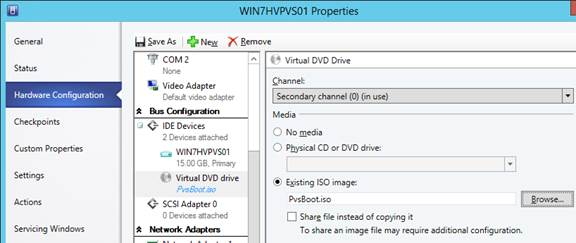
- Switch to the Hardware Configuration > Firmware page
- Move PXE Boot or IDE Hard Drive to the top.
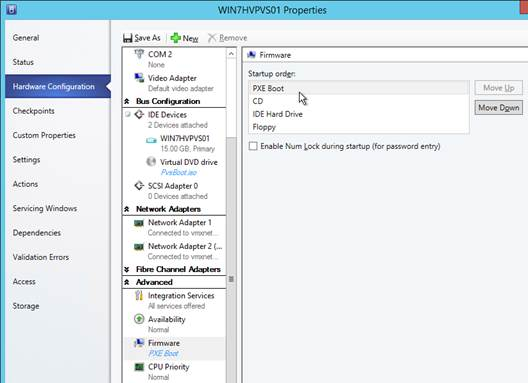
- Click OK to close the virtual machine properties.
- Power on the virtual machine.
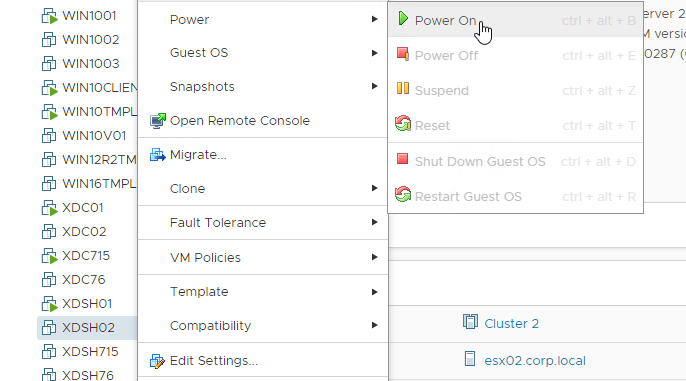
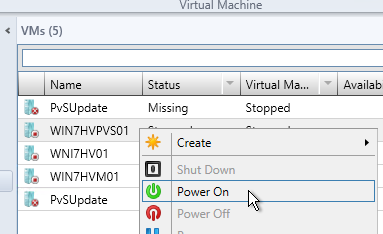
- If vSphere EFI:
- Boot the virtual machine.
- In the Boot Manager, don’t select a boot option. Instead, go to Enter Setup.
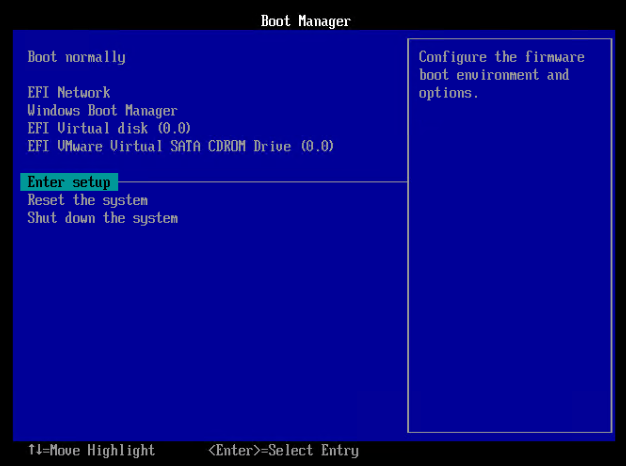
- Go to Configure boot options.

- Go to Change boot order.

- Press <Enter> on Change the order.
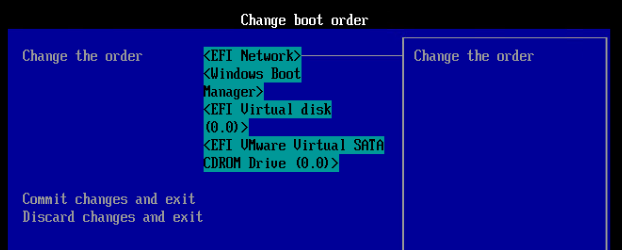
- Use the plus icon on your number pad to move EFI Network to the top.

- Commit changes and exit.
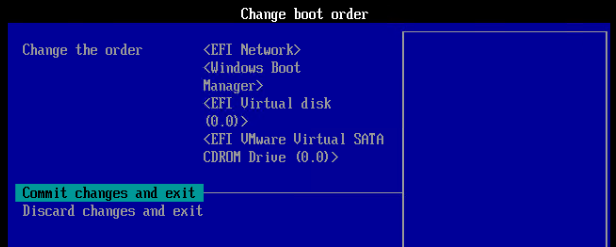
- Exit the Boot Maintenance Manager.
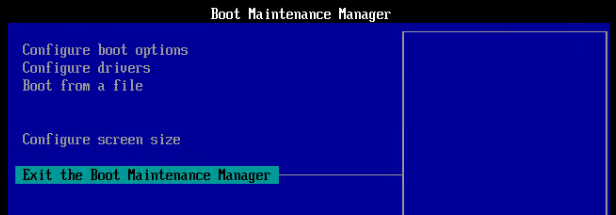
- Now boot from EFI Network.
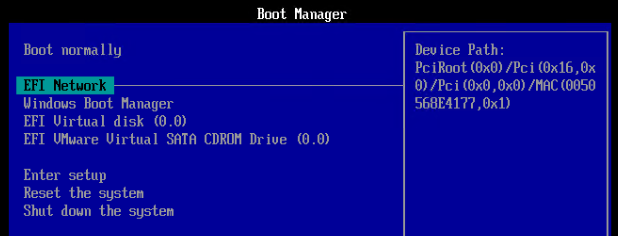
- If vSphere BIOS:
- Boot the virtual machine.
- In the Virtual Machine’s console, on the Boot tab, move Network boot or CD-ROM Drive to the top.
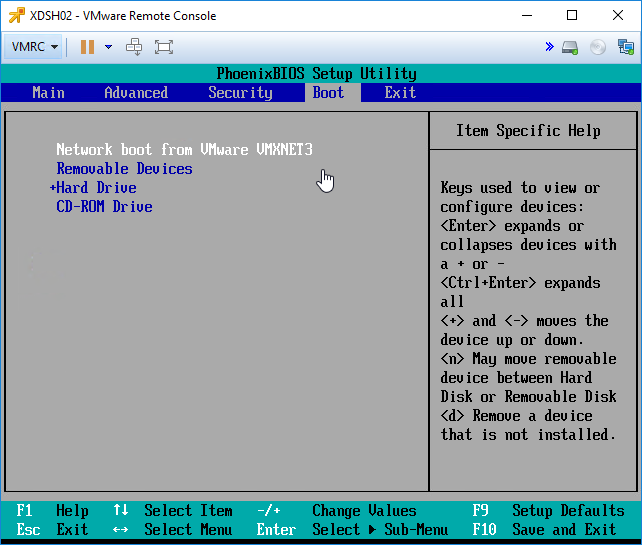
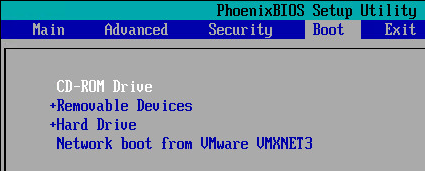
- Press F10 to close the BIOS Setup Utility.
- You should see the virtual machine boot from a Citrix Provisioning server and find the vDisk.
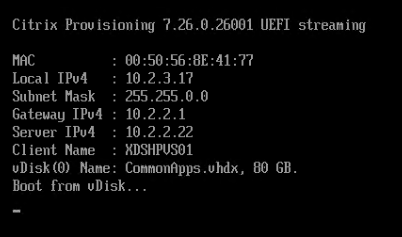
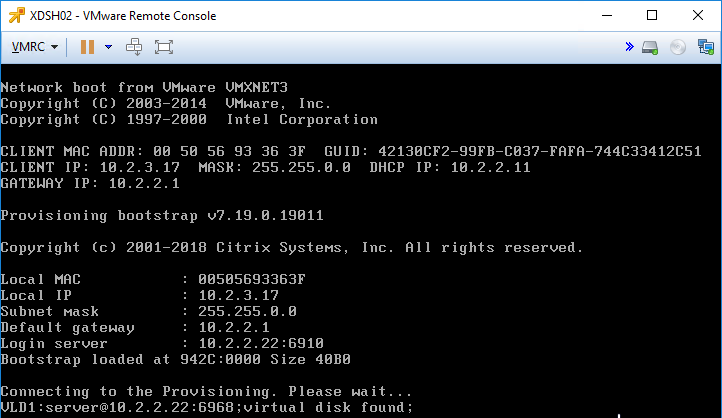
- Once the machine has booted, login. If you see a Format Disk message, just ignore it, or click Cancel. The Imaging Wizard will format it for you.
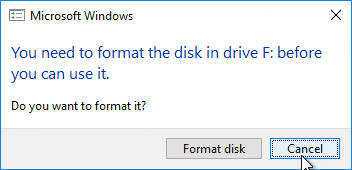
- The conversion wizard will commence. It will take several minutes to copy the files from C: drive (local hypervisor disk) to vDisk (Citrix Provisioning disk) so be patient.
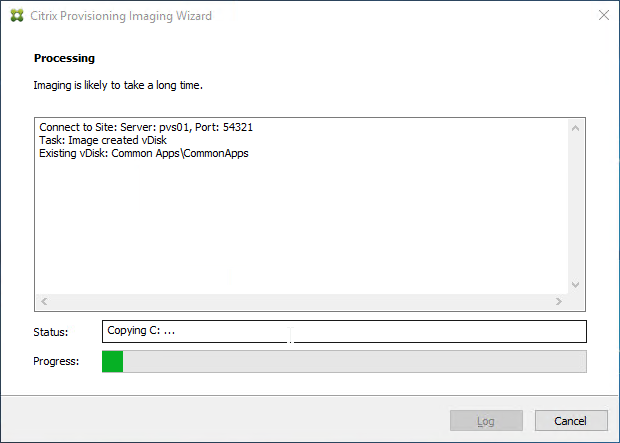
- If the Imaging Wizard does not successfully copy the local drives to the vDisk, first make sure the vDisk is mounted by opening the systray icon.
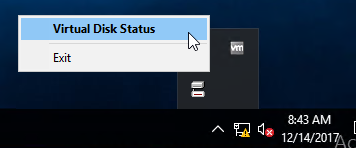
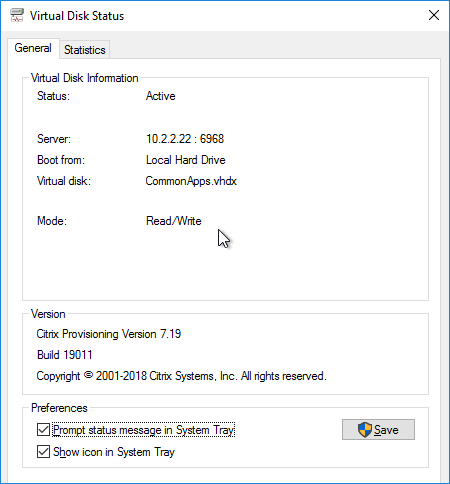
- Then you can manually start the conversion by running C:\Program Files\Citrix\Provisioning Services\P2PVS.exe.
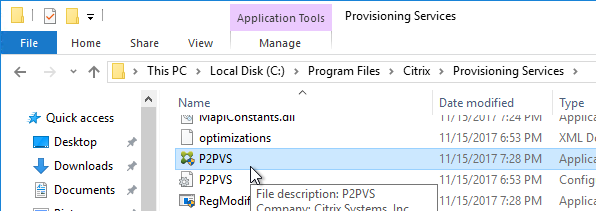
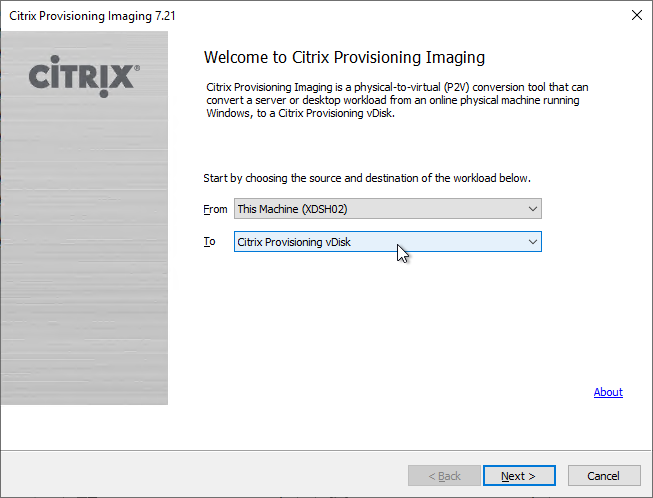
- If the Imaging Wizard does not successfully copy the local drives to the vDisk, first make sure the vDisk is mounted by opening the systray icon.
- When done, click Done. It might prompt you to reboot. Reboot it, log in, and then shut it down.
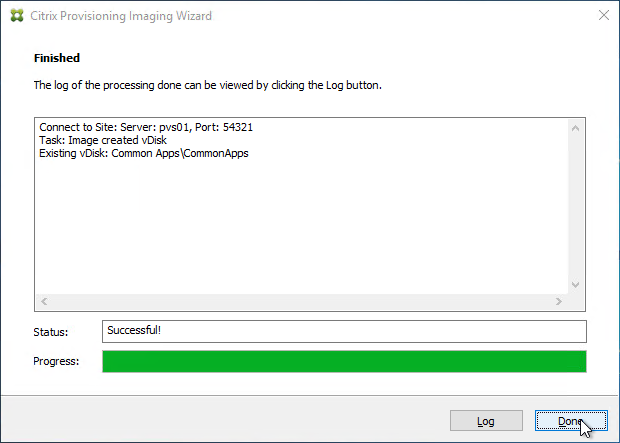
Master Target Device – Join to Domain
Citrix Provisioning must learn the password of the Target Device’s Active Directory computer account. To achieve this, use the Citrix Provisioning Console to create or reset the computer account.
Do not use Active Directory Users & Computers to manage the Target Device computer account passwords. Creating, Resetting, and Deleting Target Device Active Directory computer objects must be done from inside the Citrix Provisioning Console so Citrix Provisioning will know the computer’s password. Citrix Provisioning will automatically handle periodic (default 7 days) changing of the computer passwords.
- In the Citrix Provisioning Console, right-click the new Target Device, expand Active Directory, and click Create Machine Account.
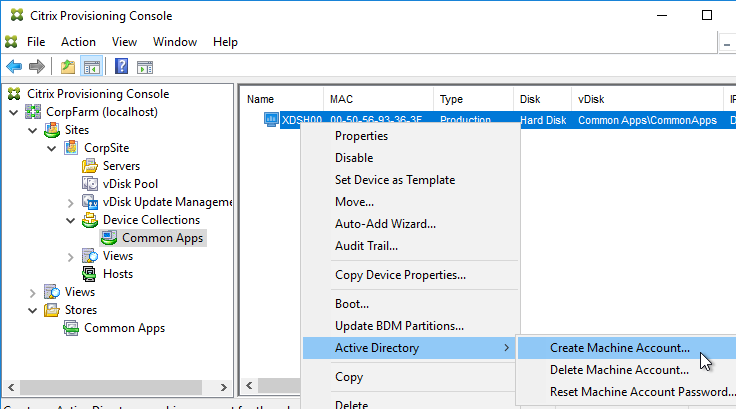
- Select the correct OU in which the Active Directory computer object will be placed, and click Create Account.
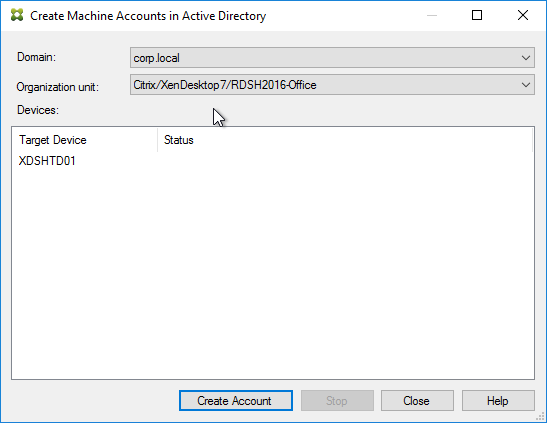
- Then click Close.
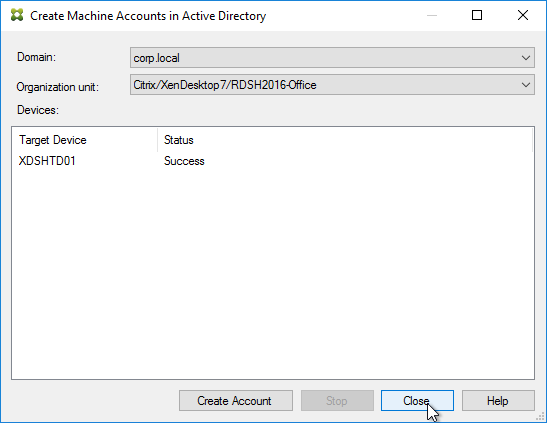
Boot from vDisk
- In the Citrix Provisioning Console, go to the Device Collection.
- Right-click the new device, and click Properties.
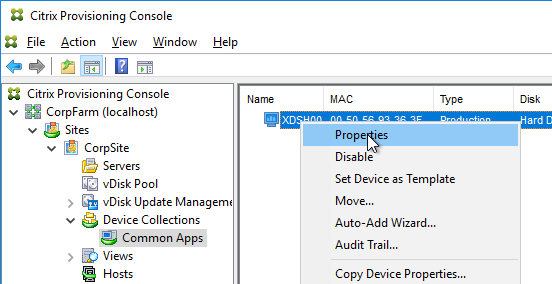
- On the General tab, set Boot from to vDisk.
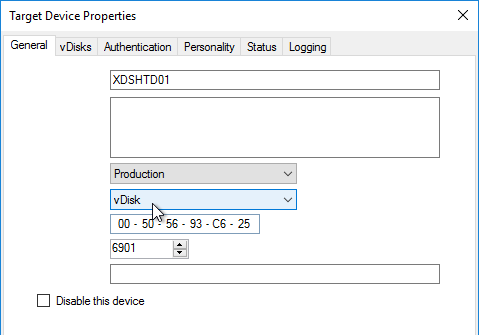
- Restart the Target Device.
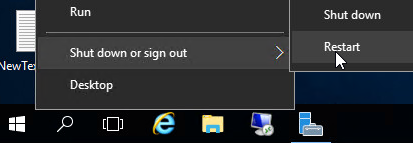
- At this point it should be booting from the vDisk. To confirm, in the systray by your clock is an icon that looks like a disk. Double-click it.
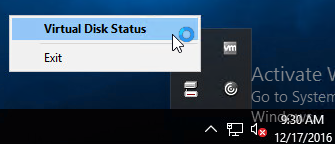
- The General tab shows it Boot from = vDisk, and the Mode = Read/Write.
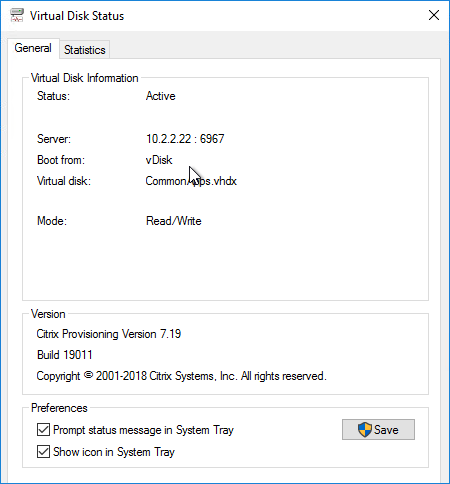
vDisk – Save Clean Image
If you have not yet installed applications on this image, you can copy the VHDX file and keep it as a clean base image for future vDisks.
- If this vDisk is in Private Image mode, first power off any Target Devices that are accessing it.
- Then you can simply copy the VHDX file and store it in a different location.
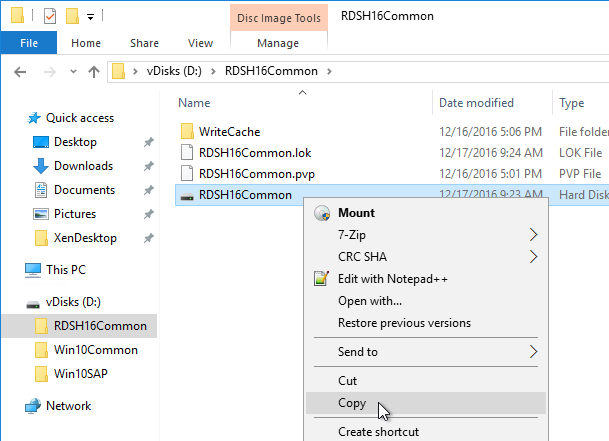
If you later need to create a new vDisk, here’s how to start from the clean base image:
- Copy the clean base image VHDX file to a new folder.
- Rename the file to match your new Image name.
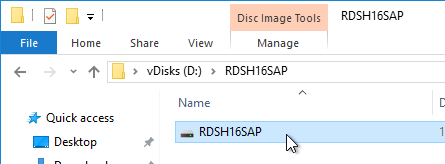
- In the Citrix Provisioning Console, create a new Store, and point it to the new folder.
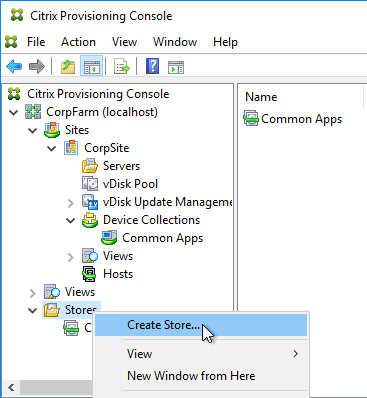
- Give the new Store a name.
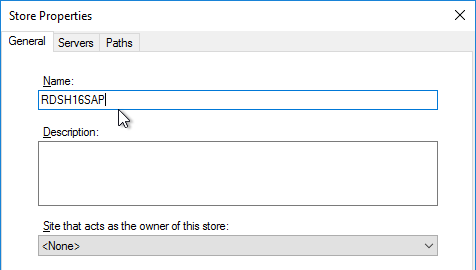
- On the Servers tab, select all Provisioning servers.
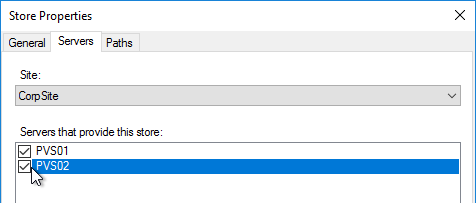
- On the Paths tab, enter the path to the new folder. Click OK.
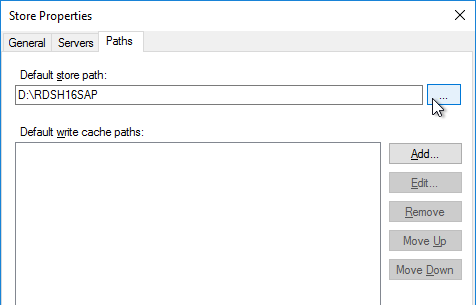
- Click OK when asked to create the default write cache.
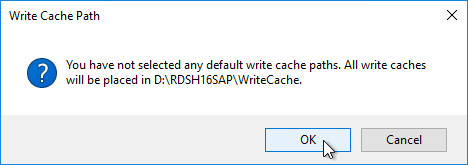
- Right-click the new store and click Add or Import Existing vDisk.
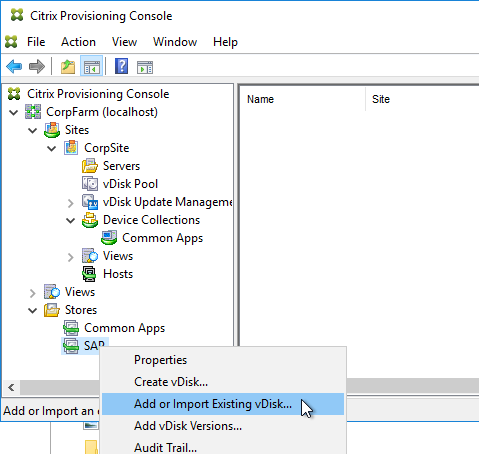
- Click Search.
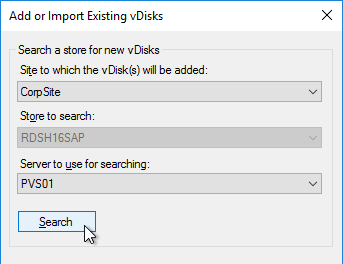
- Click OK if prompted that a new property file will be created with default values.
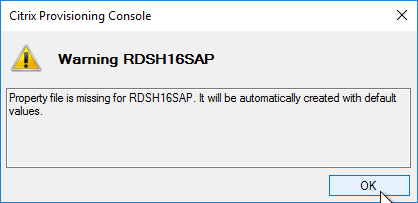
- Click Add, click OK, and then click Close.
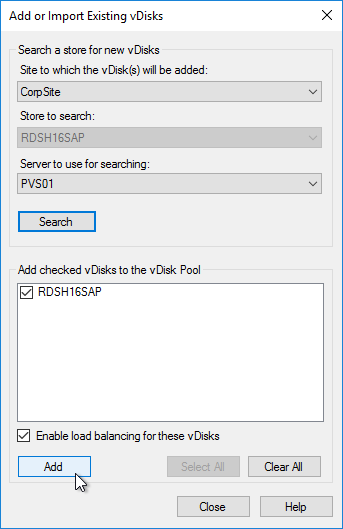
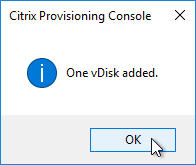
- You can now assign the new vDisk to an Updater Target Device and install applications.
KMS
Skip this section if you are using Active Directory-based Activation instead of KMS Server.
This only needs to be done once. More information at CTX128276 Configuring KMS Licensing for Windows and Office.
- Make sure the Citrix Provisioning services are running as an account that is a local administrator on the Provisioning Servers. Citrix Provisioning needs to mount the vDisk but only local administrators can mount VHDX files.
- In the Citrix Provisioning Console, right-click on the virtual disk, and select Properties.
- Click on the tab named Microsoft Volume Licensing, and set the licensing option to None. Click OK.
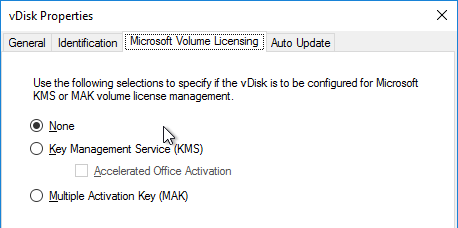
- Boot an Updater device from the vDisk in Private Image mode.
- Login to Windows and rearm the system for both Windows and Office, one after the other.
- For Windows Vista, 7, 2008, and 2008R2: Run cscript.exe slmgr.vbs -rearm
- For Office (for 64-bit client): C:\Program Files(x86)\Common Files\Microsoft shared\OfficeSoftwareProtectionPlatform\OSPPREARM.EXE
- For Office (for 32-bit client): C:\Program Files\Common Files\Microsoft shared\OfficeSoftwareProtectionPlatform\OSPPREARM.EXE
- A message is displayed to reboot the system, DO NOT REBOOT- Instead, run sealing tasks and then shut down the Target Device.
- In the Citrix Provisioning Console, right-click on the virtual disk, and select Properties.
- Click on the tab named Microsoft Volume Licensing, and set the licensing option to Key Management Services (KMS).
- In Citrix Provisioning 1906 and newer, also check the box next to Accelerated Office Activation.
- Click OK.
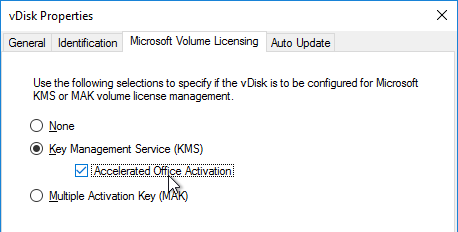
Note: After streaming the vDisk to multiple Target Devices, Administrators can validate that the KMS configuration was successful by verifying that the CMID for each device is unique.
- For Windows: Run cscript.exe slmgr.vbs –dlv
- For Office: Run C:\Program Files\Microsoft Office\Office16\cscript ospp.vbs /dcmid
Also see Citrix Blog Post Demystifying KMS and Provisioning Services
vDisk – Seal
Do the following sealing steps every time you switch from Private Image mode to Standard Image mode, or promote a Maintenance Image to Test or Production.
- Run antivirus sealing tasks. See VDA > Antivirus for links to various antivirus vendor articles.
- Citrix Blog Post Sealing Steps After Updating a vDisk contains a list of commands to seal an image for Citrix Provisioning.
- Citrix Blog Post PVS Target Devices & the “Blue Screen of Death!” Rest Easy. We Can Fix That has a reg file to clear out DHCP configuration.
- Shut down the target device.
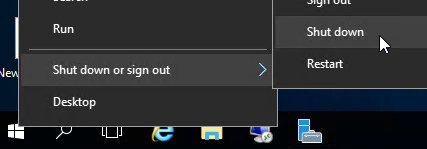
- Note: Base Image Script Framework (BIS-F) automates many sealing tasks. The script is configurable using Group Policy.
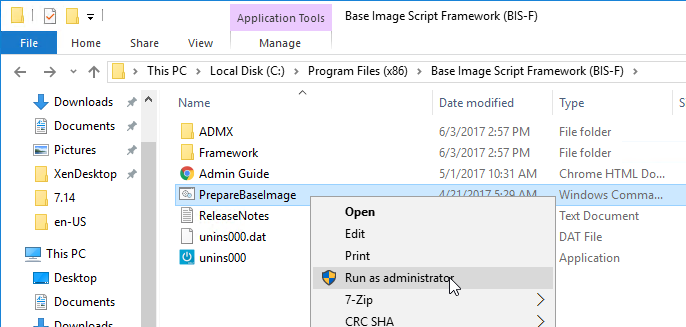
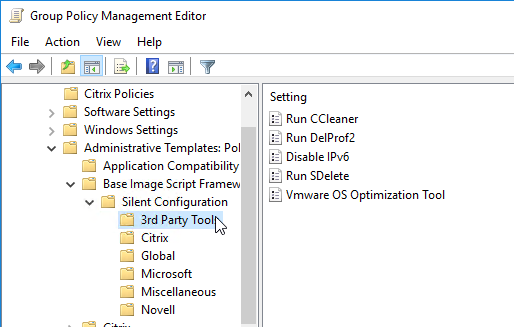
Defrag the vDisk
In the Citrix Blog Post Size Matters: PVS RAM Cache Overflow Sizing, Citrix recommends defragmenting the vDisk.
If the vDisk was created by App Layering ELM, then Gunther Anderson at Performance considarations? at Citrix Discussions says there’s no point in doing a defrag.
- While still in Private Image mode, right-click the vDisk, and click Mount vDisk.
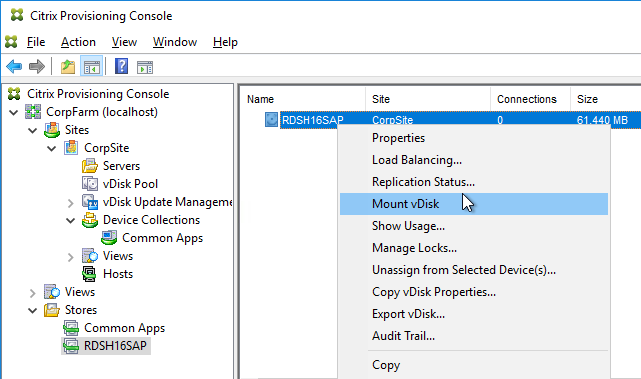
- In File Explorer, find the mounted disk, right-click it, and click Properties.
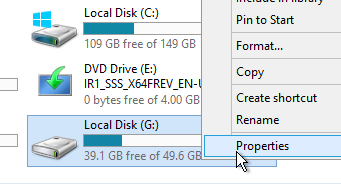
- On the Tools tab, click Optimize.
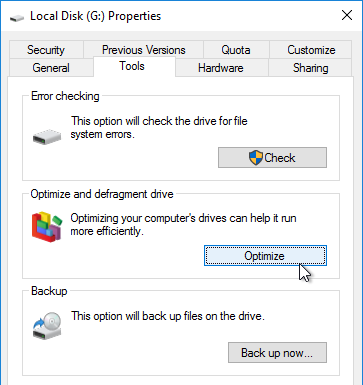
- Highlight the mounted drive and click Optimize.
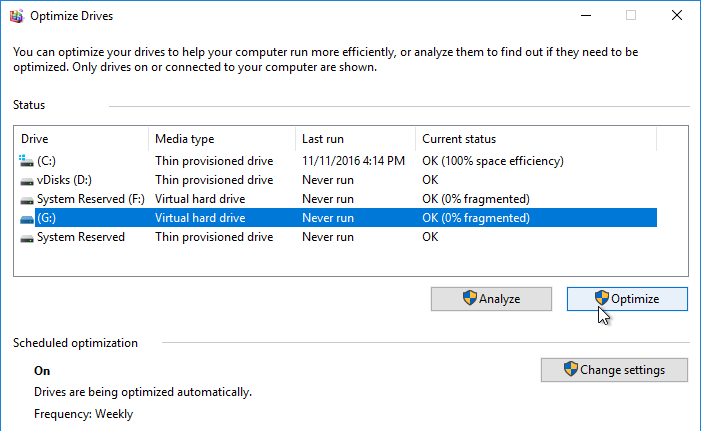
- When done, back in Citrix Provisioning Console, right-click the vDisk, and click Unmount vDisk.
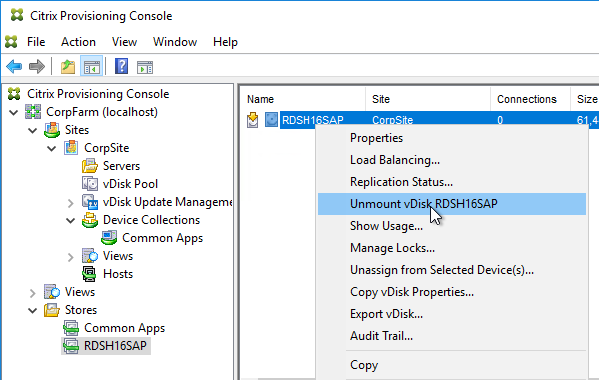
Standard Image Mode
- In the Citrix Provisioning Console, go to the vDisk store, right-click the vDisk, and click Properties.
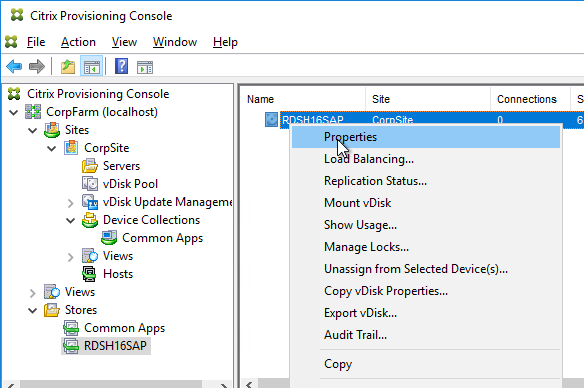
- On the General tab:
- Change the Access Mode to Standard Image.
- Set the Cache Type to Cache in device RAM with overflow on hard disk. Don’t leave it set to the default cache type or you will have performance problems. Also, every time you change the vDisk from Standard Image to Private Image and back again, you’ll have to select Cache in device RAM with overflow on hard disk.
- Change the Maximum RAM size to a higher value. For virtual desktops, set it to 512 MB or larger. For Remote Desktop Session Hosts, set it to 4096 MB or lager. Make sure your Target Devices have extra RAM to accommodate the write cache.
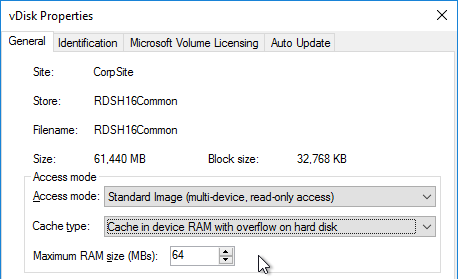
- On the bottom of the General tab is a new checkbox to disable cleanup of cached secrets. By default, Citrix Provisioning 7.12 and newer will delete any cached credentials. This behavior can be disabled by checking the box.

- Click OK when done.
vDisk – High Availability
- In the Citrix Provisioning Console, right-click the vDisk, and click Load Balancing.
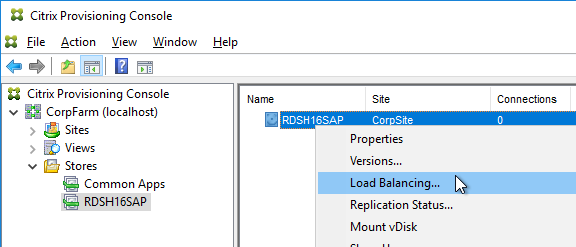
- Ensure Use the load balancing algorithm is selected. Check the box next to Rebalance Enabled. Click OK.
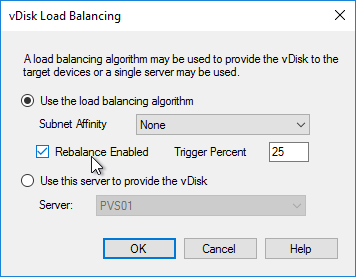
- Go to the physical vDisk store location (e.g. D:\Win2016Common) and copy the .vhd and .pvp vDisk files for the new vDisk. Do not copy the .lok file.
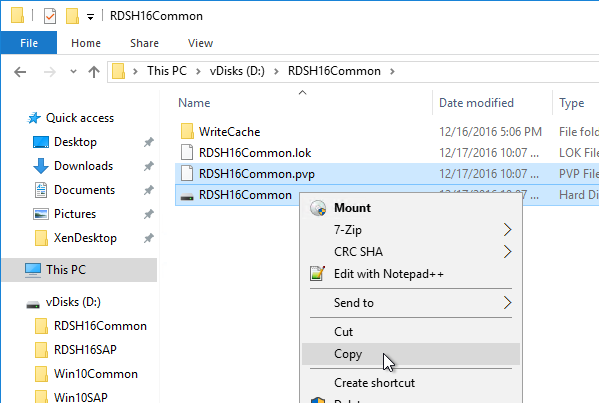
- Go to the same path on the other Provisioning Server and paste the files. You must keep both Provisioning Servers synchronized.
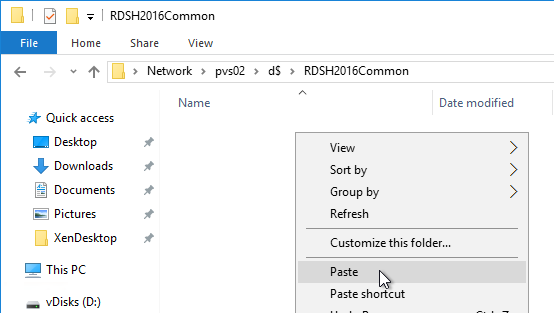
- Another method of copying the vDisk files is by using Robocopy:
Robocopy D:\vDisks\ \\pvs2\d$\vDisks *.vhd *.avhd *.pvp *.vhdx *.avhdx /b /mir /xf *.lok /xd WriteCache /xo
- Citrix Blog Post The vDisk Replicator Utility is finally finished! has a GUI utility script that can replicate vDisks between Citrix Provisioning Sites and between Citrix Provisioning Farms.
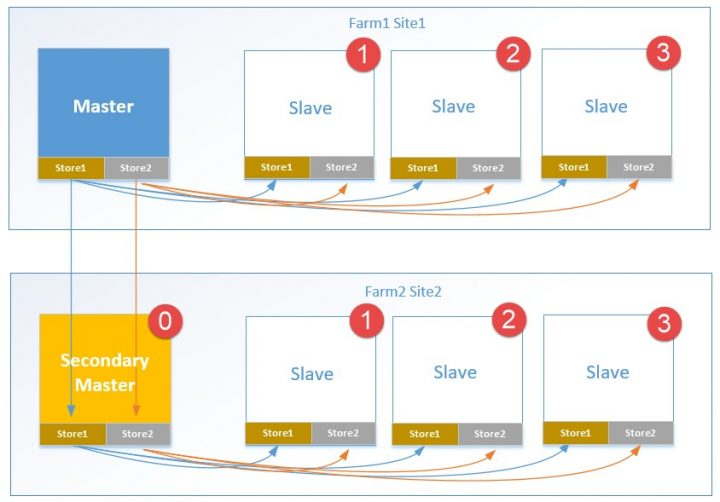
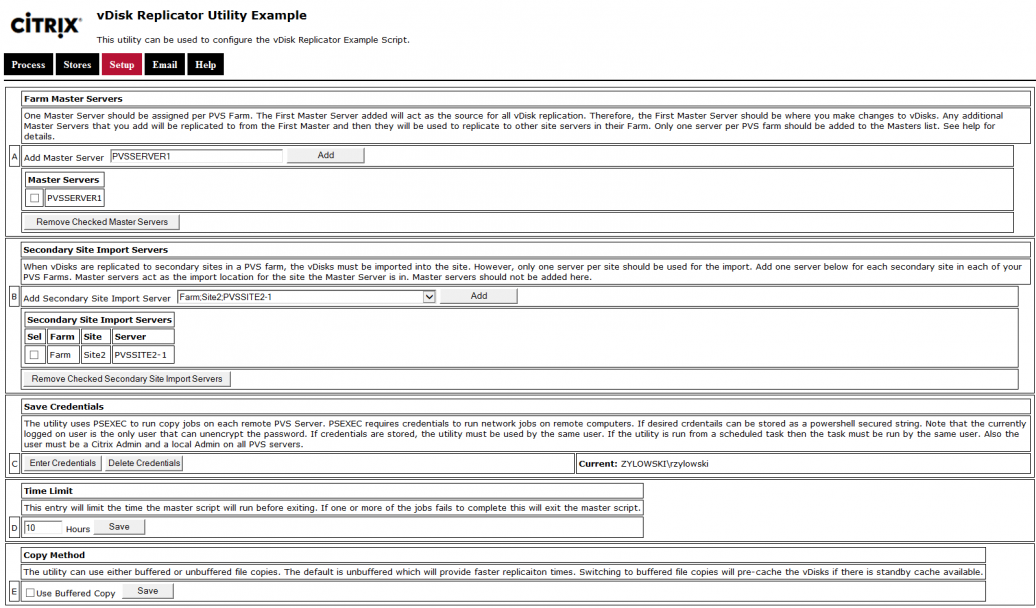
- In the Citrix Provisioning Console, right-click the vDisk, and click Replication Status.
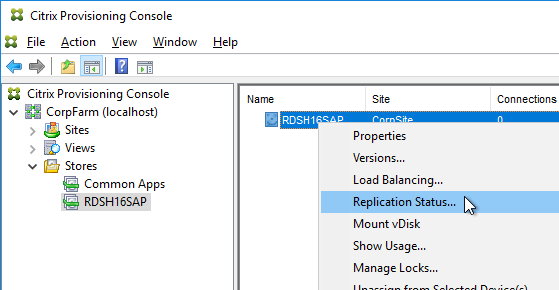
- Blue indicates that the vDisk is identical on all servers. If they’re not identical then you probably need to restart the Citrix PVS Stream Service and the Citrix PVS SOAP Service. Click Done when done.

Cache Disk – vSphere
Here are vSphere instructions to remove the original C: drive from the Master Target Device, and instead add a blank cache disk.
- In vSphere Client, right-click the Master Target Device, and click Edit Settings.
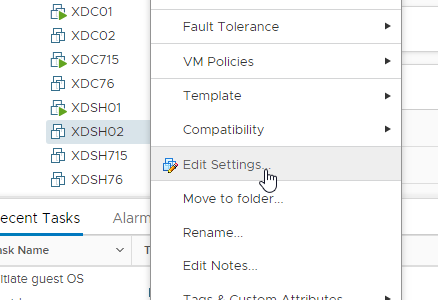
- Select Hard disk 1, and click the x icon. Click OK.
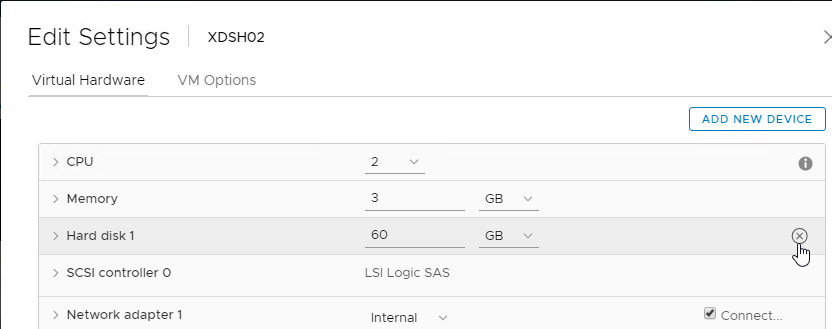
- Edit the Settings of the virtual machine again.
- On the top right, click Add New device, and select Hard Disk.
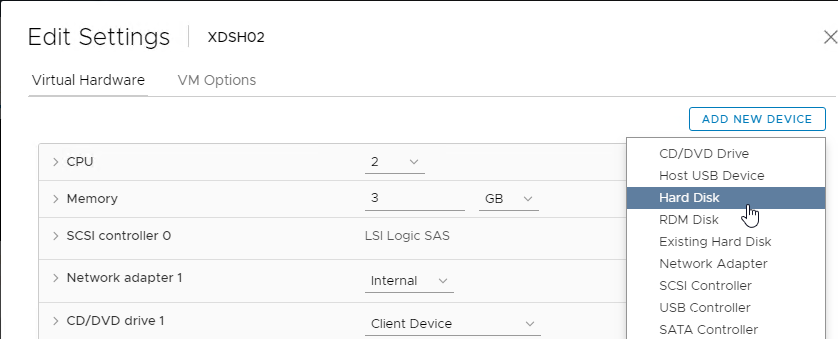
- This is your cache overflow disk. Size is based on the type of VDA.
- 40 GB is probably a good size for session hosts.
- For virtual desktops this can be a smaller disk (e.g. 5 GB).
- Note: the pagefile must be smaller than the cache disk.
- Expand the newly added disk, and set Disk Provisioning to Thin provision if desired. Click OK when done.
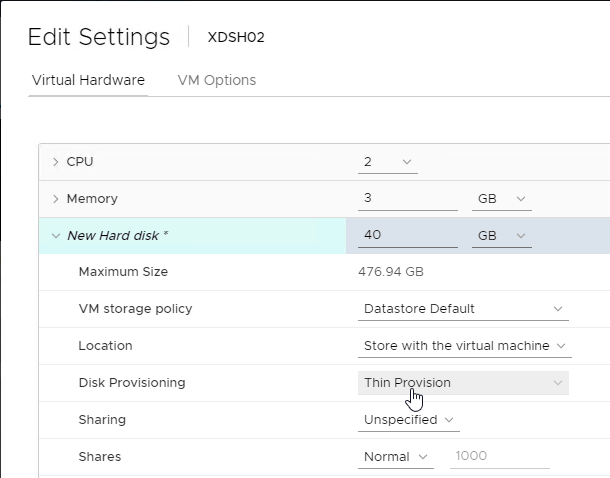
- Configure group policy to place the Event Logs on the cache disk.
- Boot the Target Device and Verify the Write Cache Location.
Cache Disk – Hyper-V
Remove the original C: drive from the Target Device and instead add a cache disk.
- Edit the settings of your Citrix Provisioning master virtual machine and remove the existing VHD.
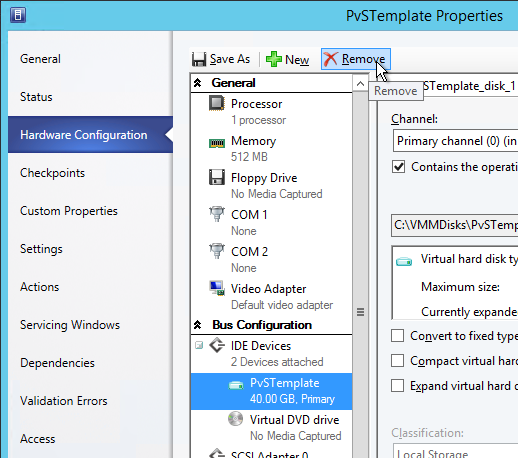
- Make a choice regarding deletion of the file.
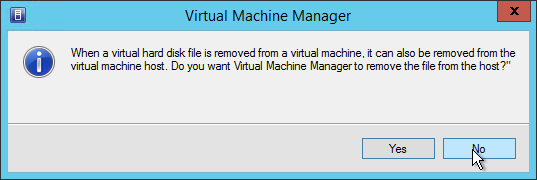
- Create a new Disk.
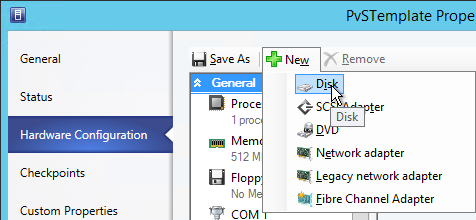
- This is your cache overflow disk. 15-20 GB is probably a good size for session hosts. For virtual desktops this can be a smaller disk (e.g. 5 GB). Note: the pagefile must be smaller than the cache disk. Click OK when done.
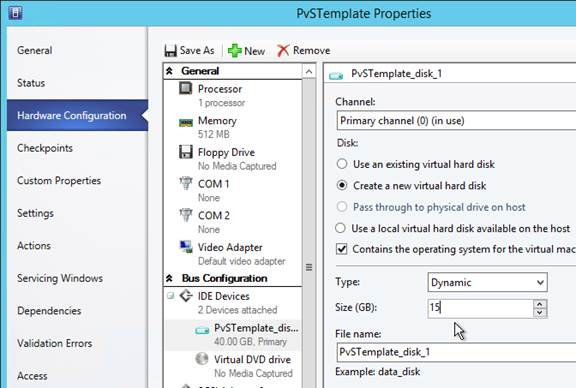
- Configure group policy to place the Event Logs on the cache disk.
Verify Write Cache Location
- Boot the target device virtual machine.
- Open the Virtual Disk Status window by clicking the Citrix Provisioning disk icon in the system tray by the clock.
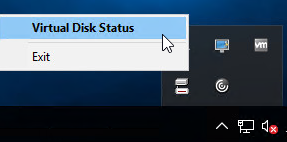
- Make sure Mode is set to Read Only and Cache type is set to device RAM with overflow on local hard drive.
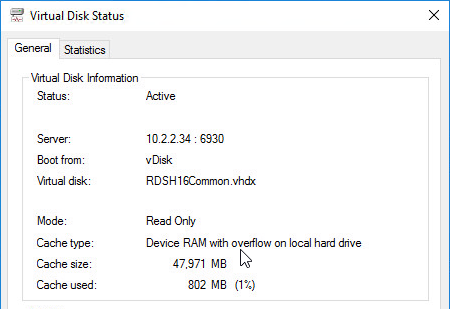
- If Cache type says server, then follow the next steps:
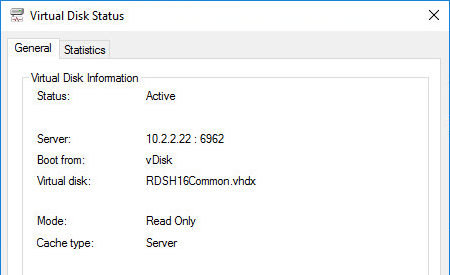
- For the cache disk, if machine uses BIOS, then only MBR is supported. GPT only works with EFI/UEFI machines.
- The cache disk must be a Basic disk, not Dynamic.
- Format the cache disk with NTFS.
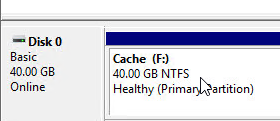
- Make sure the pagefile is smaller than the cache disk. If not it will fail back to server caching.
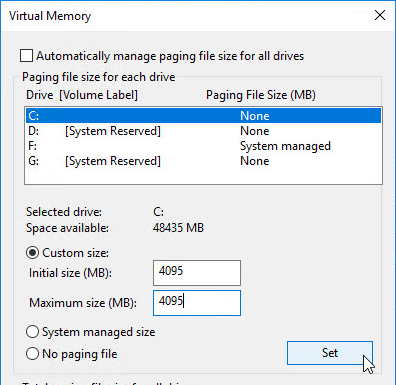
- After fixing the problem and rebooting, the Cache Type should be device RAM with overflow on local hard drive.

- To view the files on the cache disk, go to Folder Options, and deselect Hide protected operating system files.
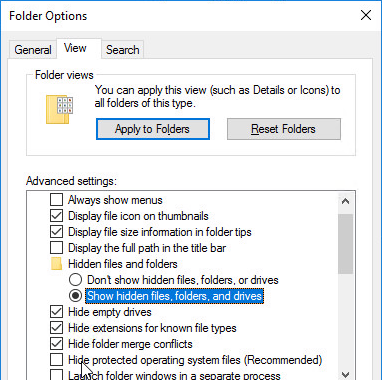
- On the cache disk, you’ll see the pagefile, and the vdiskdiff.vhdx file, which is the overflow cache file.
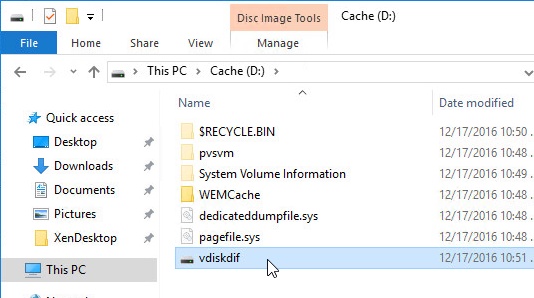
Hi Carl,
I am facing very strange issue with target device.
I gets unregistered. We are using Citrix PVS 2203 LTSR to build Windows 2022 multi session hosts.
Upon checking I found below time sync issues. It syncs the time from local CMOS, insted of the domain controllers and due to this it losts trust relation with the domain controller, hence unregistered,
Leap Indicator: 3(not synchronized)
Stratum: 0 (unspecified)
Precision: -23 (119.209ns per tick)
Root Delay: 0.0000000s
Root Dispersion: 0.0000000s
ReferenceId: 0x00000000 (unspecified)
Last Successful Sync Time: unspecified
Source: Local CMOS Clock
Poll Interval: 6 (64s)
To fix it I tried these steps in a new maintenance vdisk,
1. Be sure the W32Time service is running and set to automatic start.
2. From an elevated command prompt run> w32tm /config /syncfromflags:domhier /update.
3. Check the time status > w32tm /query /status
Running w32tm /resync will force and automatic update with the configured time source.
Sealed vDisk, created new TD out of it. When I booted it, it still shows time sync from local CMOS, and VM broke trust relation with the DC.
Any help would be highly appreciated.
Thanks.
hi Carl,
i have an issue where my windows 10 vdi (made through PVS). Keep falling off the domain whenever they are restarted. so i have to keep resetting the account password for them or deleting the machine accounts and remaking them through PVS. what have i done wrong ? I swear ive not encountered this issue before.
Hi, you may have to create this GPO to prevent AD to manage PVS TD account password reset. Computer Configuration > Policies > Windows Settings > Security Settings > Local Policies > Security Options > Domain Member: set “Disable machine account password changes” to “Enable”. See if this helps. It did help in my environment when machines faling out of the domain. Good luck.
Hi Carl,
I faced an issue while creatig a Windows 2022 PVS vDisk.
After I ran imaging wizard, VM successfully booted in network. However, after logging in to the image it did not automatically start/commence the conversion wizard.
I have recreated master VM few times and each time it stucks at this stage. After reboot the conversion wizard will not commence.
What could be the issue here?
For information, both master VM and PVS server are in the same subnet.
Thank you,
Murtuza
Run the tool ‘P2PVS’ located at C:\Program Files\Citrix\Provisioning Services
Hi Carl,
This helped and I have now successfully created the PVS vDisk.
I have another issue that I have posted in this forum.
Please help.
Thanks
I’ve got the cache type set to device RAM with overflow on local hard drive.
Due to the other software im running on the endpoint, my cache is getting filled pretty quickly by one of the security tools. Is there a way to exclude certain directories from being cached. Perhaps with a registry key or some other setting/configuration.
Hi Carl,
I am getting “retry limit exhausted.Error numbver 0xE0070004.” while running imaging wizard.
Any Ideas?
Thank you
Does it work at all? I suspect a networking problem between the device and the server. Or maybe you’re storing the vDisk on slow storage.
Hi Carl,
It worked initially but device wasn’t network booting with new vDisk. PVS server was in a different vlan than the VM. I have then moved the PVS server in target device vlan.
I am storing the vdisk on same PVS server.
I think I ran imaging wizard a lot of time to troubleshoot network booting. Do you think there is a counter somewhere that might have a counter for number of times one can run imaging wizard?
Thank you,
Murtuza
Hi Carl,
It is fixed now. I had changed the IP of the PVS server and realized that Management IP was still pointing to the old one. So, run the PVS Configuration Wizard again which has fixed the issue.
Thanks.
Best regards,
Murtuza
Hi Carl,
I’m trying to image a Server 2022 VM using the PVS Imaging Wizard. The VM is configured with two separate (virtual) “physical” disks—one for the C: drive and another for the D: drive. I’d like to image both disks into a single image, as I’ve done many times before. However, when I select “Choose partitions to image,” only the C: drive appears.
Initially, I thought this might be due to the Target Device version (2203 CU5), so I tried installing earlier versions, but the issue persisted. It seems the Imaging Wizard is only recognizing the primary disk and ignoring the others. I couldn’t find any reference to PVS not supporting multiple disks, so I’m reaching out to you for assistance.
I’d appreciate any help you can provide!
Thank you!
Are they separate disks instead of separate partitions on one disk?
Hi,
We found out what the problem was: The VM (vMware) was configured as EFI instead of BIOS.
We changed the boot configuration to BIOS and then we were able see all disks in the imaging wizard.
Thanks!
Not sure where to post this… it’s kind of a question in the opposite direction of this PVS section. We have a situation where we need to move from PVS to standalone VMs (in vSphere) as our one site has drastically decreased in size and the PVS overhead is not justified. We are unable to rebuild the servers from scratch (software and knowledge losses/gaps), unfortunately, so we are faced with trying to get them out of PVS as they are. Any suggestions would be greatly appreciated. Is it as simple as running a conversion utility on the merged base vhd file?
Did you try to reverse image? https://www.carlstalhood.com/pvs-update-vdisk/#reverseimagebcdedit
Cache drive in vmware esxi not opening
Giving an error d drive is not accessible
Is it formatted?
Hi Carl,
We use Citrix CVAD 7.15 LTSR. Today while creating PVS Imaging wizard, I don’t get an option to add the target device.
I select an option to “Create a vDisk”. Click “Next”. In this window it directly gives me to enter vDisk Name, Store Name and Disk Type and no option to “Add a target Device”.
Can you help.
Has it ever worked? I’m not sure if something changed between 7.15 and 1912 and I haven’t done PVS on 7.15 in quite a while.
Hi Carl! Thanks for awesome blog! I have latest CVAD 7 (PVS) 2012 build in my environment and doing everything exactly how you describe above. But when i am using imaging wizard after reboot it does not relaunch automatically and i have to use P2V.exe. After that the vdisk is ready, i boot from it and cannot login: trust between workstation and domain failed. WS account i made from PVS console in AD. Maybe you have any idea? Thanks!
Carl –
This blog has had better information than Citrix documentation and phone support combined.
Hopefully you have run into what we’re experiencing and have a solution or suggestion.
We’re using 1912 LTSR and using PVS as the boot drive for our network.
We have had issues with our UEFI versions of images booting with cache on RAM.
They appear to run out of the allocated 12GB of RAM and blue screen almost daily.
We’ve verified pagefile is disabled and Citrix keeps recommending we select “Cache in device RAM with overflow on hard drive,” even after we tell them having a hard drive is not an option.
We’d love to cache in RAM and overflow to server, but that isn’t an option.
We did see that selecting Cache in device RAM with overflow on hard drive without having a hard drive installed would cause the cache to failover to cache on server with a vdisk.
However, it only caches on server, not RAM, then the vdisk on the server.
I had hoped there was a way to trick the console by mapping a drive letter to the \\server\share we use for server cache and use the Cache in device RAM with overflow on hard drive option to get the best of both worlds.
Any advice or suggestions would be much appreciated.
Thank you.